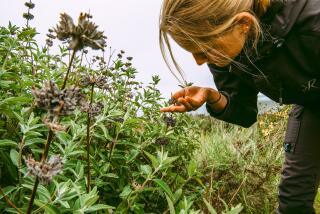Back to Nature : Scientists Build Caves to Give Condor Chicks a Head Start on Life in the Wild
VENTURA — Think of it as a preschool for baby vultures.
Four endangered California condor chicks, born in captivity and fresh from their nests, will be enrolled as the first students.
The 3-month-old hatchlings will live in separate man-made mini-caves in the hills of Ventura County, where scientists hope they will get a head start on learning what it takes to survive in the wild.
Until now, the chicks have been held in a rearing facility at the Los Angeles Zoo as part of a $15-million condor recovery program aimed at bringing the California condor back from the brink of extinction.
But their location next to the zoo’s maintenance yard exposed them to such urbanized noises as traffic, the backup beeps of heavy equipment and even human voices.
Civilization has proved deadly for five condors previously released into the wild, and scientists hope to keep the birds unfamiliar with and fearful of man.
“The chicks were basically in a plywood and steel building at the zoo where they couldn’t see the sky,” said David Clendenen, senior wildlife biologist with the U.S. Fish and Wildlife Service and a 12-year veteran of the condor recovery program.
“Here, each will have its own nest cave, with an outside pen where they can feel the wind and see the sky and interact more with their environment,” he said.
Clendenen spoke from the ranch house at the Hopper Mountain Wildlife Refuge, high in the hills of the Los Padres National Forest about six miles northeast of Fillmore as the condor flies.
When the new facility opens at Hopper Mountain in late July, it will mark the return of the condors to Ventura County, at least temporarily.
Hopper Mountain offers a quiet spot to prepare the young condors for the outside world, teaching them to stay clear of people and power poles.
If the training condors receive at Hopper Mountain proves successful, scientists will consider releasing more birds nearby at the site of the Sespe Condor Sanctuary, where the first condors bred in captivity were released in early 1992.
That first introduction of captivity-bred condors to Ventura County met with some setbacks. One of the giant vultures died from drinking antifreeze and three others had fatal crashes with power poles.
Because of the condor deaths, officials decided the Sespe site was too close to civilization, so the remaining three condors were captured and moved to a more remote location in Santa Barbara County. At the same time, another flock of condors raised in captivity was released in the same Santa Barbara County area.
But another of the condors initially raised in Ventura County died at that location, and scientists concluded that bad habits were simply too ingrained in the Sespe birds, no matter where they were taken. They returned the remaining Sespe birds to the Los Angeles Zoo.
The man-made rock caves at the newest condor location are about half a mile from the ranch house where members of a team of six field biologists live when they are on duty. The caves are nestled at the foot of a ridge near a running creek in a small hollow. Surrounding them are the golden hills and cliffs of the Los Padres.
Made of light-colored artificial rock designed to look like the sandstone formations of the Los Padres backcountry, the caves measure 3 feet wide by 6 feet long and 4 feet high. Each of the six caves, almost complete, has an outdoor penned-in area that is 8 by 12 feet.
When the birds reach about six months of age, they will be transferred as a group to a 30-by-50-foot flight pen constructed nearby, where a wired power pole will shock the birds every time they land on it.
“It’s used for negative conditioning to teach them to stay off power poles in the wild,” Clendenen said.
The same kind of aversion therapy has proved successful so far in Santa Barbara County, where six condors have been avoiding trouble with civilization. But scientists are not sure how they will act as they grow older.
Marc Weitzel, project leader for the Fish and Wildlife Service, said the investment in the latest condor experiment is minimal, about $50,000, with electric company giant PG&E; helping cover the costs of keeping the birds away from power poles.
The first four birds transferred to the Hopper Mountain site will have an additional advantage: They will have been reared for the first three months of their lives by their own parents.
Until now, all other eggs laid as part of the captive breeding program at the Los Angeles and San Diego zoos have been quickly removed from their nests to encourage the adult birds to mate again. Called double or triple clutching, the practice helped increase the condor population to 104, including the six in the wild.
Members of the condor recovery team hope that allowing the chicks’ parents to rear them, even for a few months, will somehow make them better adjusted adults.
“I don’t know if parents can impart anything in captivity that will make the birds successful later,” said Robert Mesta, project coordinator. “It’s not like you can tell them, ‘Hey, kid, watch out for this when you get out in the world.’ ”
But Mesta said the training could have some beneficial effects that experts simply cannot predict.
“And it can’t hurt,” he said.
More to Read
Sign up for Essential California
The most important California stories and recommendations in your inbox every morning.
You may occasionally receive promotional content from the Los Angeles Times.










